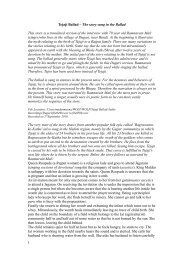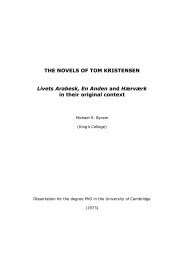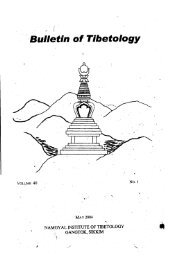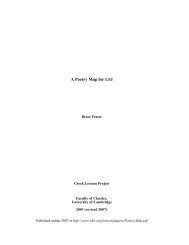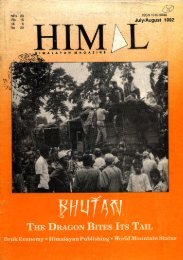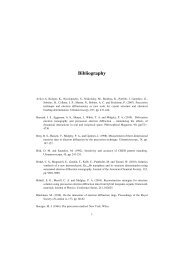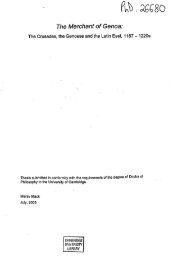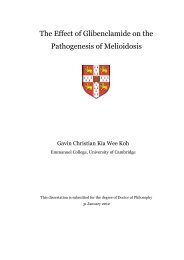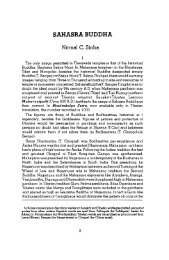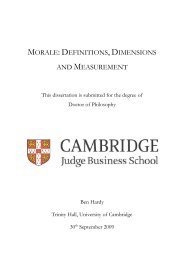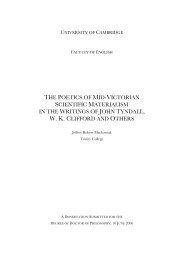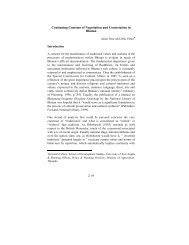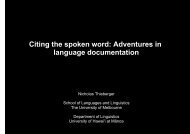Hinayanism
Hinayanism
Hinayanism
You also want an ePaper? Increase the reach of your titles
YUMPU automatically turns print PDFs into web optimized ePapers that Google loves.
and the impressive Dance scene in the Cave No.7 are perhaps<br />
the most outstanding examples of its art-expression. There<br />
is no doubt that the sculptors of these caves have already<br />
attained great control over rock-art and were at the same<br />
time caring more for self-expression than for traditional forms.<br />
The entire range of caves is dateable perhaps to the late<br />
seventh to later eighth centuries A.D. There is a Hinayana<br />
Chaitya also (Cave No.4). There is a striking representation<br />
of Mahaparinirvana of the Buddha in Cave No.8 and 9.<br />
NAGARJUNAKONDA: A study of the provenance of<br />
Buddhist sites in South India would show that there were<br />
five main ancient routes which converged in the Vengirastra<br />
and led to Kalinga, Dravida, Kamata, Maharastra and to<br />
Kosala respectively. Necessarily the lower Krishna Valley<br />
was a particularly propitious zone for the proliferation of<br />
the Buddhist creed and River Krishna (Maisolos of the<br />
Greeks) was the life giving arterial water-way that united<br />
together the trading patrons given to far flung voyages and<br />
devoted monks who annihilated distance to spread the gospel<br />
of the Buddha. The vaHey of Nagarjunakonda (in Guntur<br />
District) was discovered in 1936. Since then systematic salvage<br />
excavations for nearly six years from 1954 had to be undertaken<br />
to retrieve all that was historically and archaeologically<br />
valuable in the valley before leaving it to the rising catchment<br />
water level of the giant Nagaljunasagar proJcct; the<br />
hundreds of sites of early Buddhist faith, mostly of Mahayana<br />
that dotted the valley have revealed an outstanding and new<br />
chapter in the history of Andhra Pradesh and of early Buddhism<br />
at Vijayapuri, as the city here was anciently caBed, and at<br />
Sri Parvata as the hill range from here to Srisailam was<br />
also perhaps called. From the scores of inscriptions that<br />
we have here ( one of which would seem to be also of the<br />
time of Yajna' Satakami) which are mostly of the Iksvaku<br />
(Ikkhaku) dynasty-the successors of the Satavahanas here-we<br />
get a glimpse of the remarkable part played by nearly<br />
half a dOL-ell distinguishcd ladies of the royal house and<br />
princesses, who though their lords were patrons of Hinduism,<br />
themselves promoted the cause of Buddhism. We have names<br />
of many viharas of the various denominational sects of<br />
early Buddhism like Bahusrutiya Vihara, Mahisasaka Vihara,<br />
Chula Dharrnagiri Vihara, Aparamahavinaseliya Vihara<br />
Purvaseliya Vihara, Kulaha Vihara and Simhala Vihara, not,<br />
to mention the M aha chetiya in the centre of the valley<br />
which is mentioned as holding in its bosom the corporeal<br />
relics of Lord Buddha himself.<br />
16



